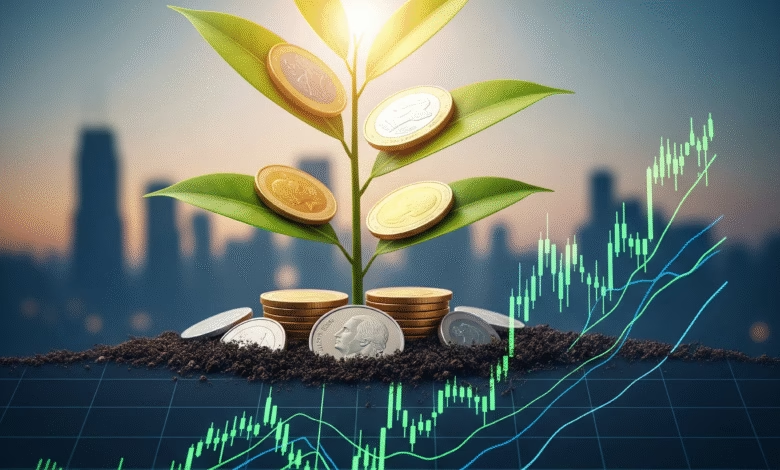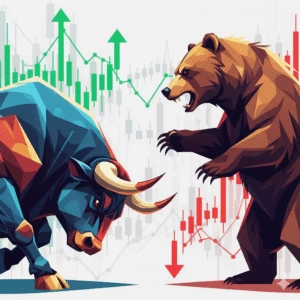
What if you could get paid simply for owning a piece of a successful company? Not just by selling your shares for a profit years down the line, but by receiving regular cash payments directly into your account, like clockwork. This isn’t a fantasy; it’s the reality of dividend investing, one of the most powerful and time-tested strategies for building long-term wealth.
For new investors, the concept of dividends can seem a bit mysterious. How does it work? Where does the money come from? And how can you harness this strategy for your own financial goals?
This guide will demystify the world of dividends completely. We will break down exactly what they are, why companies pay them, and the crucial mechanics of how they work. We’ll explore the key metrics you need to know, the incredible power of reinvesting, and even how dividends are taxed. By the end, you’ll have a rock-solid understanding of how these shareholder rewards can become a cornerstone of your investment portfolio.
What Are Dividends? A Simple Explanation

At its most basic level, a dividend is a distribution of a portion of a company’s earnings to its shareholders.
Think of it this way: When you buy a stock, you become a part-owner of that business. If you owned a small local pizza shop with a partner, and the shop had a very profitable year, you would both decide what to do with the extra money. You might reinvest some of it back into the business to buy a new oven, but you would likely decide to pay yourselves some of the profits for being the owners.
A dividend is the exact same concept on a much larger scale. When a large, publicly-traded company like Apple or Coca-Cola makes a profit, its board of directors decides what to do with that money. They will reinvest a portion to grow the business (research, new factories, marketing), but if there is cash left over, they may choose to distribute it directly to their owners—the shareholders.
This payment is your reward for providing the company with your capital and sharing in the risk of ownership. It’s a tangible return on your investment, separate from any potential increase in the stock’s price.
Why Do Companies Pay Dividends?
If a company can use its profits to grow bigger and faster, why would it choose to give that money away to shareholders? The decision to pay a dividend is a powerful signal about the company’s health, maturity, and philosophy.
1. A Sign of Financial Strength and Stability
A company that can consistently pay a dividend, and even increase it year after year, is sending a clear message to the market: “Our business is healthy, our profits are real, and we are confident in our financial future.” Young, fast-growing companies often need every dollar they can get to fund their expansion. Mature, established companies (often called “blue-chips”) generate more than enough cash to both fund their operations and reward their investors.
2. To Attract and Retain Investors
Dividends are a major draw for a certain class of investors, particularly those focused on generating a steady income stream, such as retirees. By offering a reliable dividend, companies can attract a loyal base of long-term shareholders who are less likely to sell their shares during periods of market volatility.
3. A Demonstration of Shareholder-Friendly Management
A commitment to paying dividends shows that the company’s management is focused on delivering direct value to its owners. It imposes a sense of discipline on the leadership team, forcing them to be efficient with capital and avoid wasteful spending, as they know a portion of the profits is already earmarked for shareholders.
How Do Dividends Actually Work? The Four Key Dates

The process of receiving a dividend isn’t instantaneous. It follows a specific timeline involving four important dates. Understanding these is crucial for any dividend investor.
1. Declaration Date
This is the day the company’s board of directors officially announces that it will be paying a dividend. The announcement will include the amount of the dividend per share and the other three key dates in the process.
2. Ex-Dividend Date (or Ex-Date)
This is the most important date for you, the investor. The ex-dividend date is the cutoff point for being eligible to receive the upcoming dividend. You must own the stock before the ex-dividend date to receive the payment. If you buy the stock on or after the ex-date, the previous owner gets the dividend. On the ex-dividend date, the stock’s price will typically drop by approximately the amount of the dividend, as the value of that payment is no longer attached to the stock.
3. Date of Record
This is the date on which the company looks at its official records to see who its shareholders are. If you are a registered owner of the stock on the date of record, you will be sent the dividend payment. Since stock trades take one business day to settle (a process known as T+1), you must buy the stock at least one business day before the record date to be a shareholder on time. This is why the ex-dividend date is set one business day before the record date.
4. Payment Date
This is the day the dividend is actually paid out. The money is electronically transferred to your brokerage account. Hooray!
Key Metrics Every Dividend Investor Must Know
When evaluating a dividend-paying stock, you can’t just look at the dividend amount. You need to use a few key metrics to understand the full picture of its value and sustainability.
Dividend Yield
This is the most commonly cited dividend metric. It tells you how much a company pays in dividends each year relative to its stock price.
- Formula: Annual Dividend Per Share / Current Share Price = Dividend Yield (%)
- Example: If a stock is trading at $100 per share and pays an annual dividend of $3.00, its dividend yield is 3%.
- What it tells you: The yield allows you to compare the income-generating potential of different stocks. However, a very high yield can be a red flag. It might mean the stock price has fallen dramatically due to problems with the business, putting the dividend at risk of being cut.
Payout Ratio
This metric tells you what percentage of a company’s net income is being paid out to shareholders as dividends.
- Formula: Annual Dividend Per Share / Earnings Per Share (EPS) = Payout Ratio (%)
- Example: If a company earns $5.00 per share and pays a $2.00 dividend, its payout ratio is 40%.
- What it tells you: The payout ratio is a crucial indicator of dividend safety. A low-to-moderate payout ratio (e.g., 30-60%) is generally healthy. It means the company is easily covering its dividend payments with its profits and has room to grow the dividend in the future. A payout ratio over 100% means the company is paying out more than it’s earning, which is unsustainable and a major warning sign.
Dividend Growth Rate
For long-term investors, the dividend growth rate can be even more important than the current yield. This metric shows the annualized rate at which a company has been increasing its dividend over time. A company with a lower current yield but a high growth rate can become a more powerful income generator over the years than a company with a high starting yield but stagnant growth.
The Power of Reinvesting Dividends: Introducing DRIPs
Receiving a cash dividend is great, but the real magic happens when you reinvest those dividends to buy more shares of the same stock. This process creates a powerful compounding effect that can dramatically accelerate the growth of your wealth over time.
Think of it as a snowball rolling down a hill. The small snowball (your initial investment) picks up more snow as it rolls (your reinvested dividends), making it bigger. The now-larger snowball picks up even more snow on its next revolution, and so on.
Many brokerages offer a Dividend Reinvestment Plan (DRIP). By enrolling in a DRIP, your dividends are automatically and immediately used to purchase more shares (or even fractional shares) of the stock, often with no commission fees.
Let’s see a hypothetical example:
- You invest $10,000 in a stock with a 3% dividend yield.
- Year 1: You receive $300 in dividends. With a DRIP, that $300 buys more shares.
- Year 2: You now have $10,300 worth of the stock. Your 3% dividend is now calculated on this larger amount, giving you $309. This is reinvested.
- Year 3: You start with $10,609, which generates a $318 dividend.
Over 20 or 30 years, this effect becomes profound. The dividends you earn start earning their own dividends, leading to exponential growth that far outpaces what you would achieve by simply taking the cash.
Finding the Best Dividend Stocks: The “Dividend Aristocrats”

For investors seeking the highest quality, most reliable dividend-paying companies, a great place to start is the “Dividend Aristocrats.” This is an exclusive group of companies in the S&P 500 index that have not only paid a dividend but have increased their dividend for at least 25 consecutive years.
Achieving this status is a testament to a company’s incredible stability, disciplined management, and durable competitive advantages. These companies have proven they can continue to grow their profits and reward shareholders through recessions, market crashes, and technological disruptions. An even more elite group, the “Dividend Kings,” have raised their dividends for over 50 consecutive years.
Dividends and Taxes: What You Need to Know
Unfortunately, dividends are not free money; they are considered investment income and are subject to taxes. In the U.S., dividends fall into two main categories, each with a different tax treatment.
Qualified Dividends
These are the most common type of dividends from U.S. companies and certain foreign corporations. To be “qualified,” you must have held the stock for a certain period (typically more than 60 days). Qualified dividends are taxed at the more favorable long-term capital gains tax rates, which are 0%, 15%, or 20%, depending on your overall taxable income.
Ordinary (or Non-Qualified) Dividends
These dividends do not meet the IRS requirements to be qualified. They are taxed at your regular income tax rate, which is the same rate you pay on your salary or wages and is typically higher than the capital gains rates.
It’s important to note that if you hold your dividend stocks within a tax-advantaged retirement account, such as a 401(k) or a Roth IRA, you do not have to pay taxes on the dividends each year. The investments grow tax-deferred or tax-free, which is a major advantage.
A Proven Path to Building Wealth

Dividends are one of the most powerful and accessible tools available to investors. They provide a steady stream of income, signal the financial health of a company, and, when reinvested, can supercharge your portfolio’s growth through the miracle of compounding.
While they are often associated with a more conservative investment style, they are a crucial component of a well-rounded strategy for investors of all ages. They are not a get-rich-quick scheme. Rather, they are a testament to the power of patience, discipline, and long-term ownership in high-quality businesses. By understanding how dividends work, you can unlock a strategy that has been a reliable engine of wealth creation for generations.





